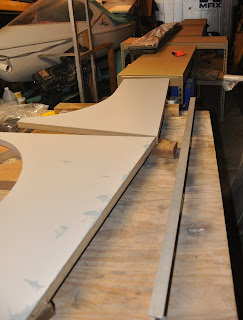Sanding, T-Nuts, Gearbox and Workspace
It has been a while since the last post. Progress is being made, but a bit slower than expected.
The seat back looks like it would be a great place to store things. The foam bulkhead would diminish the space available - or at a minimum split it in two. I wonder if it is really needed for a plywood boat seat back.
While I was shopping for a sander I came across the Festool brand. Apparently it is one of the top sanders on the market, starting at US$175 plus several hundred dollars more for the more or less mandatory Festool shop vac. They both were nice and quiet, and the sander did not vibrate excessively. Maybe if I was in the professional boat building business I could justify the purchase, but since I'm not....(yet) :-)
I bought a "vibra free" random orbital sander from Sears. It is the same as the Rockwell model, having two concentric counter rotating surfaces. The vibration was indeed reduced compared with another sander I tried, but I didn't feel like I had as much control as I needed when trying to smooth the outriggers.
It did a fairly decent job on the excess resin and fillet material on the seat back, but I managed to put some ring-shaped depressions into the ply that I really didn't want. The edges are nicely rounded for when the exterior is taped and glassed.
The Vibra-free sander did a reasonable job on the outriggers. In the end I returned it to the store and got a cheaper Sears Professional random orbital sander, one with adjustable speeds. I also got a longer hose for the shop vac and hooked it to that for dust removal. The Sears sander seems to have not much difference in vibration from the "vibra-free", but the sanding was more predictable.
I think the stabilizers are just about ready for their next coat of resin and tape over the cloth. However, I want to also glass and glue the threaded hard points for attaching the stabilizers so their is a molecular bond as well as a mechanical bond.

Since the boat will be in salt water, stainless steel or some means of non-corrosive connection needs to be employed. So, I picked up a couple of different kinds T nuts from Fisheries Supply.
They had three types: small pressed stainless buttons, large standoffs with a large pressed-in regular steel base, and large standoffs with a large stainless base. The second style was the only one that didn't have a hole going through the base - which was exactly what I wanted. Unfortunately, however, it had regular steel where it was pressed in, so that made it a non-starter.
I bought a bunch of both the smaller button-style and the larger stainless standoffs.
The larger ones might be adequately secured with a layer of 12 oz. glass, but the smaller ones probably would need a layer of plywood with holes drilled, plus a layer of glass.

Meanwhile, the Involute gearbox arrived from George Tatum. It certainly is a heavy beast, but not a whole lot heavier than the drive system on a Cadence. The unit needs a bit of breaking in, too, as I could not turn the spindle with my fingers.
Lastly, I spent quite a bit of the weekend clearing out a section of the garage for assembling the hull. A spare shelving unit was separated into two sections and placed in the garage, and the other shelving unit already in the garage was also split into two units.

Joined almost end to end the shelving units were very close in height, making for a nice, long workbench.
I had to place some other panels on top of my regular workbench to match the height, but now I have a fairly consistent and level surface that should work for assembling the hull.

1 Comments:
For a good orbital sander review see: http://www.clcboats.com/life-of-boats-blog/boat-builder-random-orbital-sander-roundup.html
Post a Comment
<< Home